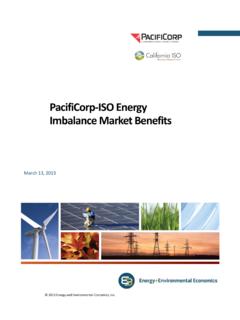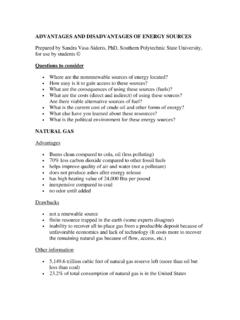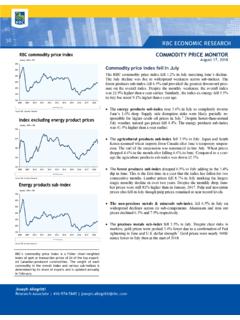Transcription of ECONOMICS OF WIND ENERGY - mragheb.com
1 ECONOMICS OF wind ENERGY . M. Ragheb 3/16/2017. INTRODUCTION. wind ENERGY capital costs have declined steadily. A typical cost for a typical onshore wind farms has reached around $1,000/kW of installed rated capacity, and for offshore wind farms about $ 1,600/kW. The corresponding electricity costs vary due to wind speed variations, locations and different institutional frameworks in different countries. wind power accounted for percent of the USA electricity generating capacity in 2012, up from about 3 percent in 2011. Developers installed GWs of wind capacity in 2012, surpassing natural gas power plant construction to become the largest new source of electricity. The growth is driven by tax incentives, utility demand, falling costs and better technology including taller towers and lighter blades.
2 The production tax credit incentive at cents / of ENERGY production was extended for a year at the start of 2013. The rate was increased to cents in April 2013. as an adjustment to the official inflation rate. At low fossil fuel prices, wind ENERGY has not generally been cost competitive with the thermal sources of electricity generation. The pattern of development of wind ENERGY is largely dependent on the subsidies and support mechanisms provided by national governments. However, wind ENERGY prices are converging with those from the thermal sources, which have been steadily increasing as the fossil fuel resources are getting depleted both in individual nations and globally. It is not always simple to make objective comparisons, as there are few places where totally level playing fields exist.
3 60. 52. 50. 40. 30. 20. 20 16. 10 7 6. 2. 0. Figure 1. Share of electrical ENERGY production in the USA. economic CONSIDERATIONS. The big driver behind the growth in wind ENERGY investment is the falling cost of wind -produced electricity. Over the last 20 years, the cost of generating electricity from utility-scale wind systems has dropped by more than 80 percent. When large-scale wind farms were first set up in the early 1980s, wind power was costing as much as 30 cents per kilowatt-hour ( /kWhr) of the produced ENERGY . Presently, new installations in the most favorable locations can produce electricity for less than 5 /kWhr. Higher fossil fuels such as oil, coal and natural gas prices are helping to make wind power more competitive. Even where wind power is still not able to compete head-on with cheaper power sources in some locations, it is getting close.
4 At a natural gas price of $5- 15 per million British Thermal Units (BTUs), wind ENERGY becomes competitive even without the USA's Production Tax Credit (PTC) subsidy. Continued investment will depend on whether ENERGY prices of other sources will stay high. Developers of wind power installations are looking at a 20 to 30 year investment span. If natural gas prices fall over that period, a project that is now profitable could become uncompetitive a few years into the future. TRANSMISSION AND GRID ISSUES. Transmission costs are a major issue in wind ENERGY development. Some of the best locations for generating wind ENERGY are far distant from the consuming industrial and population centers. Some areas have a better, more reliable source of wind power than others. Although half the USA's installed wind power capacity is based in Texas and California, the greatest potential for wind generation can be found in areas where there is little demand for electrical power.
5 For instance, there exists a significant amount of wind potential in North Dakota, but there are just not a lot of people or industries in North Dakota to consume the electrical power. The highest wind speeds exist in the remote and inaccessible Aleutian Islands in Alaska and necessitate an ENERGY storage and conveyance medium such as hydrogen from water as a transportation fuel in fuel cells. A massive upgrade of the transmission lines nationwide through the national electrical power grid using High Voltage DC instead of High Voltage AC is needed to tap those distant sources. Where water supplies are abundant, along seashores or internal lakes or rivers, the electricity produced could be used for extracting hydrogen from water through the electrolysis process. Hydrogen then can become the storage medium and ENERGY carrier of wind ENERGY .
6 It would be conveyed or transmitted to the ENERGY consumption sites possibly through the existing natural gas pipeline system which covers the USA. Another alternative is to convert hydrogen with coal into methane gas, CH4 that could be distributed through the existing natural gas distribution grid without significant modifications. Methane itself can be converted into methanol or methyl alcohol, CH3OH. as a liquid transportation fuel. In the long term, to reduce the electrical transmission losses, one can envision superconducting electrical transmission lines cooled with cryogenic hydrogen carrying simultaneously electricity and hydrogen from the wind ENERGY production sites to the consumption sites. Such a visionary futuristic power transmission system could also provide the electrical power for a modern mass transit system using Magnetically-levitated (Maglev) high speed trains transporting goods and people supplementing the current highway system in the USA.
7 wind ELECTRICITY COST AND PRICE. Data attributed to two USA sources: a Department of ENERGY projection for the period 2000-2005 and an analysis for the state of Oregon in 2000 shows a gap between wind and gas prices with wind larger than coal. Other USA data suggest that wind prices can be brought down to around 4 in some locations. Figure 2. Electricity prices in / ( ) in the USA over the period 2000-2005. An important characteristic of wind ENERGY production is that there is no such thing as a point price for wind ENERGY . A linear relationship does not mathematically exist. This is so since the annual electricity production will vary largely depending on the amount of wind available at a given wind turbine site. Thus a single price for wind ENERGY does not exist, but rather a price interval or range, depending on wind speeds.
8 Figure 3. Cost of electricity for a 600 kW wind turbine as a function of its power output. Figure 3 shows how the cost of electricity produced by a typical wind turbine varies with its power output or its annual production of ENERGY . From the graph, it can be inferred that as the ENERGY produced per year is doubled, we can half the cost per of the produced ENERGY . The data apply to a Danish built MW wind turbine with a projected lifetime of 20 years, a capital investment of $585,000 including installation, an operation and maintenance cost of $6,750 per year; 5 percent/year real interest rate, and the annual turbine ENERGY output taken from a power density curve using a Rayleigh wind distribution with a shape factor of 2. One would have to modify the graph if the Operation and Maintenance (O&P).
9 Costs, which increase with turbine use, are taken into account. If the real rate of interest is 6 percent per year, rather than 5 percent per year, the costs would become percent higher than shown in Fig. 4. Figure 4. Cost of electricity at a 50 meters hub height (lower graph), and at the meteorological nominal 10 meters height (upper graph). It must be noted that wind speeds at 50 meters hub height will be 28-35 percent higher, for roughness classes in the range 1-2, than the nominal 10 meters height used for meteorological observations and wind speed reporting at different locations. For instance, a wind speed of 5 m/s at 10 meter-height in the roughness class 1 will correspond to m/s at a 50 meter hub height. It can be noticed that at high wind speeds above 9 m/s, the cost of electricity is about the same at the 10 or 50 meters heights (Fig.)
10 4). wind ENERGY COST ANALYSIS. In general, generation technologies, the cost of electricity is primarily affected by three main components: 1. Capital and Investment cost, 2. Operation and Maintenance (O&M) cost, 3. Fuel cost. However, studies of the cost of wind ENERGY and other renewable ENERGY sources could become flawed because of a lack of understanding of both the technology and the ECONOMICS involved. Misleading comparisons of costs of different ENERGY technologies are common. It is misleading to think that the amount of funds needed to pay for the purchase a wind turbine is a cost or expenditure. Even the realized profit cannot be considered as a cost. Specifically, the cost of electricity in wind power generation includes the following components: 1. economic depreciation of the capital equipment, 2.








